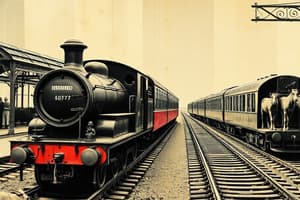Podcast
Questions and Answers
What was the driving motivator behind advancements in global transportation in the Pre-Modern world?
What was the driving motivator behind advancements in global transportation in the Pre-Modern world?
- Expansion of influence
- Technological innovation
- Improved infrastructure
- International trade (correct)
Who designed the first modern highways using inexpensive paving material of soil and stone aggregate and embanked roads?
Who designed the first modern highways using inexpensive paving material of soil and stone aggregate and embanked roads?
- Montgolfier brothers
- George Stephenson
- John Loudon McAdam (correct)
- Rudolf Diesel
Who is considered the father of railways?
Who is considered the father of railways?
- Jean-François Pilâtre de Rozier
- John Loudon McAdam
- George Stephenson (correct)
- Rudolf Diesel
What was the first passenger-carrying public railway?
What was the first passenger-carrying public railway?
Who developed the first experimental electric passenger train?
Who developed the first experimental electric passenger train?
What was the first type of man-made flying object?
What was the first type of man-made flying object?
Who made the first sustained, controlled, and powered heavier-than-air flight?
Who made the first sustained, controlled, and powered heavier-than-air flight?
What was the first commercial jet airliner to fly?
What was the first commercial jet airliner to fly?
Who achieved the first human spaceflight?
Who achieved the first human spaceflight?
Flashcards are hidden until you start studying
Study Notes
History of Transport
-
Technological innovation has been the driving force behind the history of transport, enabling people to travel farther and expand their influence over larger areas.
-
International trade was the driving motivator behind advancements in global transportation in the Pre-Modern world.
-
The first earth tracks were created by humans carrying goods and often followed trails. Animal-drawn wheeled vehicles were developed in the ancient Near East and spread to Europe, India, and China.
-
John Loudon McAdam designed the first modern highways using inexpensive paving material of soil and stone aggregate, and embanked roads.
-
The first passenger-carrying public railway was opened by the Swansea and Mumbles Railway at Oyster mouth in 1807, using horse-drawn carriages on existing tramlines.
-
George Stephenson, the father of railways, built the first intercity railway between Liverpool and Manchester in 1830.
-
In 1879, electric locomotive development was booming in Germany, with Werner von Siemens demonstrating the first experimental electric passenger train.
-
Dr. Rudolf Diesel developed a new type of railway locomotive that used a new internal combustion method to propel the railway.
-
In the Stone Age, primitive boats developed to permit navigation of rivers and for fishing in rivers and off the coast. Eventually, vessels evolved for expansion and generally grew in size for trade and war.
-
The first steamboats and later diesel-powered ships were developed during the Industrial Revolution. Canals were developed in Mesopotamia, the Indus Valley civilization, and Europe in the Middle Ages.
-
Humanity's desire to fly dates back to the first time man observed birds, leading to the invention of balloons, airships, gliders, and eventually powered aircraft and other types of flying machines.
-
Throughout history, people have relied on the sea and maritime trade, raiding, piracy, or smuggling for survival, with maritime traders most often congregating in ports, which were considered the point in which land and sea met that linked the hinterland to the wider world.A Brief History of Flight and Navigation
-
Kites were the first form of man-made flying objects, and early records suggest that they were around before 200 BC in China.
-
The first verifiable human flight took place in Paris in 1783, when Jean-François Pilâtre de Rozier and François Laurent d'Arlandes traveled 5 miles in a hot air balloon invented by the Montgolfier brothers.
-
The Wright brothers made the first sustained, controlled, and powered heavier-than-air flight on December 17, 1903, in their revolutionary aircraft, the Wright Flyer.
-
World War II saw a drastic increase in the pace of aircraft development and production, with all countries involved in the war stepping up development and production of aircraft and flight-based weapon delivery systems.
-
After the war ended, commercial aviation grew rapidly, using mostly ex-military aircraft to transport people and cargo, and the first commercial jet airliner to fly was the British De Havilland Comet.
-
In the beginning of the 21st century, subsonic military aviation focused on eliminating the pilot in favor of remotely operated or completely autonomous vehicles, and several unmanned aerial vehicles or UAVs have been developed.
-
The first human spaceflight was achieved with the Soviet space program's Vostok 1 mission in 1961, and the first spaceflight to the Moon was achieved with NASA's Apollo 11 mission in 1969.
-
The thirteenth century saw the rise of the magnetic compass for overseas travel, which allowed sailors to plot a course using magnetic north as a reference and could travel through fog and overcast.
-
Portolan charts rose up, plotting linear excursion routes, making sea navigation more accurate and efficient.
-
In 1761, the marine chronometer was invented, which allowed mariners to determine longitude while at sea.
-
Major disruptions to air travel in the 21st century included the closing of U.S. airspace following the September 11 attacks, the closing of northern European airspace after the 2010 eruptions of Eyjafjallajökull, and the COVID-19 pandemic.
-
Konstantin Tsiolkovsky's realistic dream of spaceflight dated back to his publication in 1919 of his paper 'A Method of Reaching Extreme Altitudes,' which was highly influential on Hermann Oberth and Wernher von Braun, later key players in spaceflight.
Studying That Suits You
Use AI to generate personalized quizzes and flashcards to suit your learning preferences.




